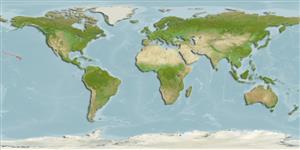>
Anguilliformes (Eels and morays) >
Ophichthidae (Snake eels) > Ophichthinae
Etymology: Callechelys: Greek, kalos, kallos = beautiful + Greek, enchelys, -yos = eel (Ref. 45335).
More on author: Snyder.
Environment: milieu / climate zone / depth range / distribution range
Ecologia
marinhas demersal; intervalo de profundidade 4 - 24 m (Ref. 58302). Tropical
Pacific Ocean: known only from the Hawaiian Islands, Midway Island and French Frigate Shoals.
Tamanho / Peso / Idade
Maturity: Lm ? range ? - ? cm
Max length : 104 cm TL macho/indeterminado; (Ref. 27478)
Benthic (Ref. 58302). Adults of most Callechelys spend most of their lives within the sediment and do not form permanent burrows. This species is exceptional and has on rare occasions been dip-netted beneath lights at the sea surface at night and has been seen encountered with its head protruding from the sand by divers at various Hawaiian locations (Ref. 27478).
Life cycle and mating behavior
Maturities | Reprodução | Spawnings | Egg(s) | Fecundities | Larvas
McCosker, J.E., 1998. A revision of the snake-eel genus Callechelys (Anguilliformes: Ophichthidae) with the description of two new Indo-Pacific species and a new Callechelyin genus. Proc. Calif. Acad. Sci. 50(7):185-215. (Ref. 27478)
Categoria na Lista Vermelha da IUCN (Ref. 130435)
Ameaça para o homem
Harmless
Utilização humana
Ferramentas
Relatórios especiais
Descarregue XML
Fontes da internet
Estimates based on models
Preferred temperature (Ref.
123201): 24.2 - 26.4, mean 25.3 °C (based on 59 cells).
Phylogenetic diversity index (Ref.
82804): PD
50 = 0.5000 [Uniqueness, from 0.5 = low to 2.0 = high].
Bayesian length-weight: a=0.00089 (0.00039 - 0.00204), b=3.00 (2.80 - 3.20), in cm total length, based on LWR estimates for this (Sub)family-body shape (Ref.
93245).
Nível Trófico (Ref.
69278): 3.9 ±0.6 se; based on size and trophs of closest relatives
Resiliência (Ref.
120179): Médio, tempo mínimo de duplicação da população 1,4 - 4,4 anos (Preliminary K or Fecundity.).
Fishing Vulnerability (Ref.
59153): High vulnerability (62 of 100).
